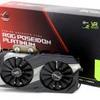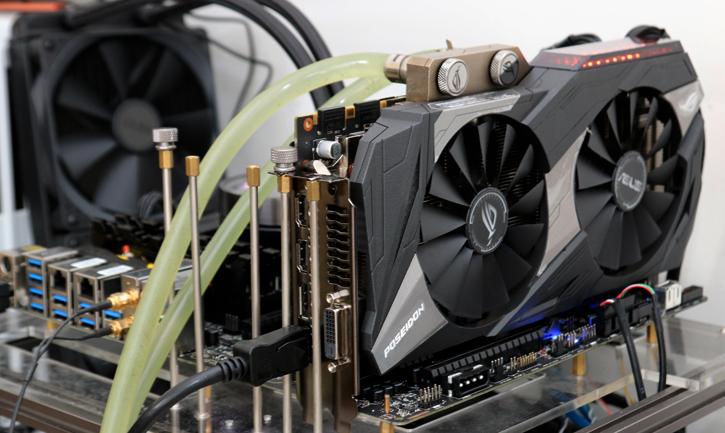Conclusion
Conclusion
The Poseidon series is always a little weird in term of how to approach it. I mean, is it a liquid or air cooled card? Well both!, but that option is totally yours of course. We predominantly say that it is a liquid cooled card as surely you're not dropping close to a full K of your cash on a graphics card with a cooling block, and then not liquid cool it. Ergo, we'll look and base our conclusion at it from that perspective. The new ROG Poseidon is beast really, it is rather innovative and very creative product. The performance is fantastic, it's factory tweaked properly straight out of the box and on liquid cooling runs at that 50 Degrees C marker (= awesome). I like the new Mirror LED effect on top of the card, but also realize it could have done without it just as well. Overall the liquid cooling and LED bling brings in that little extra x-factor feel. It is a lot of card alright, I'll comment on that in the aesthetics chapter though. The facts are simple though, it is big and bulky, but that does cool mighty fine! At a liquid cooled ~52 Degrees under any load circumstance means with long duration usage, it isn't throttling down either. Compared to a reference card overall you are looking at an up-to 7% on average extra in performance and 13% when tweaked. And that means the product as tested today passes Titan X performance levels, quite easily.
Aesthetics
The ROG Poseidon is truly a nice nice looking card. The design can be tweaked with the LEDs and tubing coolant colors of course. The overall cooler design, I like it. I remain skeptical about back-plates, I have to state that ASUS did it right, totally closed looks nicer but prevents airflow. With liquid-cooling however, not a biggy. Backplates can look good and protect your PCB and components from damage and, well, they can look nice as they can have a certain aesthetic appeal .So in the end, on looks you certainly get that premium feel of detailed aesthetics and quality. All that combined with a nicely designed 10 phase GPU setup on a dark PCB, well what's not to like, eh?
Cooling & Noise Levels
The reference design (Founders Edition) of the GTX 1080 Ti is set at an offset threshold of 80 degrees C and quite easily hit 84 Degrees C under load/stress. As such, the reference card, once that GPU gets warmer, will clock down on voltage and that dynamic turbo clock to try and keep the card at that temperature threshold. That's throttling and it's part of the design and falls within advertised turbo frequencies. The ROG Poseidon runs at around the 52 Degrees C marker on water and sits in the 75 Degrees C range on air, and with the temperature threshold set at 80 Degrees C it has no need to throttle. That means on long multi-hour gaming streaks, your card will still perform 100% at that ~1950 MHz marker. As mentioned expect (low) sound pressure values in the ~38 dBA range on air at max under load and warm circumstances. With liquid cooling the card remains passive and thus silent. We merely heard a minuscule amount of coil noises/whine at high FPS, you not hear it inside a closed chassis. Weirdly enough we seem to hear it with all 1080 Ti cards we have tested to date. You have been able to check the thermal images, no comments here either, this is a seriously properly cooled card.
Power Consumption
The GP102-350-A1 Pascal GPU is rated as having a 250 Watt TDP. This GTX 1080 Ti sits at almost 275 Watts depending on your game title and GPU load. This slightly higher wattage has everything to do with the factory tweak. At this performance level you are looking at 450~500 Watts for our PC in total, that is still okay. We think a 600~650 Watt PSU would be sufficient and, if you go with 2-way SLI, an 800~900 Watt power supply is recommended. Remember, when purchasing a PSU aim to double up in Wattage as your PSU is most efficient when it is under 50% load. Here again keep in mind we measure peak power consumption, the average power consumption is a good notch lower depending on GPU utilization. Also, if you plan to overclock the CPU/memory and/or GPU with added voltage, please do purchase a power supply with enough reserve. People often underestimate it, but if you tweak all three aforementioned variables, you can easily add 200 Watts to your peak power consumption budget.
Gaming Performance
From 1080P to Ultra HD the GeForce GTX 1080 Ti shows some serious numbers. But here's a paradox - the more difficult things get - the better the product will perform. E.g. Ultra HD is its true domain. Much like fine wine that ages well, that means this GeForce GTX 1080 Ti will last you a long time with future, more GPU intensive games. This much performance and 11 GB of GDDR5X graphics memory helps you out in Ultra HD, DSR, VR and hefty complex anti-aliasing modes. That, and of course the latest gaming titles. I consider this to be a very viable single GPU solution that allows you to game properly in Ultra HD with some very nice eye candy enabled with a single GPU. Drivers wise we can't complain at all, we did not stumble into any issues. Performance wise, really there's not one game that won't run seriously well at the very best image quality settings. Gaming you must do with a nice Ultra HD monitor of course, or at least a 2560x1440 screen. Now, we can discuss the advantages of that 11 GB frame-buffer, but hey, you can draw your own conclusions there as performance isn't limited. And with 11 GB of it, you won't run out of graphics memory for years to come, right? So in that respect the card is rather future proof.
Overclocking
This card has a nice factory tweak applied for you already. It is roughly your maximum with maybe ~50 MHz room left on that GPU base clock frequency. As such, at default this card hovers in that familiar ~1,950 MHz range and tweaked at ~2,075 MHz. Really, there is no real need to overclock per se as hey, this tweak is covered by your warranty as well. If you do want to tweak, you'll get a bit more out of the base clock and roughly 1.2 GHz on the memory. You can also allow the board power limiter to go up towards 116%. All these factors combined (power limiter/GPU clock/MEM clock) offer a notch more performance. Especially the memory tweak helps as the GP102 GPUs is a bit memory deprived.
Concluding
The new ASUS GeForce GTX 1080 Ti ROG Poseidon Platinum rocks, but sure .. also rocks your wallet. To date all 1080 Ti cards have been able to tweak at the very same level due to the limiters that Nvidia applies. E.g. the performance of all GTX 1080 Ti card are more or less the same. So why would you drop a full K of your hard earned money on this card? Well it's something only you yourself can answer, but mostly aesthetics and that exotic cooling really. Going liquid on this GTX 1080 Ti offers 52 Degrees C under load while keeping the VRM area and GDDR5X areas in line and cooled as well, that is a bit of a classic. I mean, we are talking about a GP102 GPU here and that thing is big. Once we took off the cooler and cooling plates I must admit I was impressed, the build quality and component usage just oozes quality. Granted, it's a big and heavy dude alright. The size and weight you do need to factor in though, some dislike three slot designs and that weight, well you need to secure the card properly as that's a lot of pressure on any PCI Express slot. As stated, tweaking performance is in line with any other GTX 1080 Ti though, and that means it remains limited to whatever Nvidia dictates - and that is that ~2050 MHz Boost domain. Please do keep in mind that it is a 3-slot product that weighs ~1.7 Kg, please do use that included mounting bracket if you do not have these new metal reinforced PCI-Express slots. Right, you have seen the thermal images, these show good proper results as the card throughout all locations remains at relatively proper temps. If you can pick it up for the right price then we can wholeheartedly recommend it. The heart of this beast is a GP102 GPU and it is one of the fastest graphics cards your money can get you as hey, this dawg is up-to 40% faster than the GTX 1080 and can be up-to twice as fast as one GTX 1070. In closing, we feel the ROG Poseidon is a truly lovely enthusiast class product, but you do pay for that premium in price alright. That is as far as my nagging can go as otherwise this product will get two big thumbs up. Gorgeous.
- H
Recommended Downloads
- Sign up to receive a notice when we publish a new article
- Or go back to Guru3D's front page


